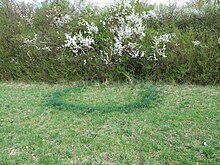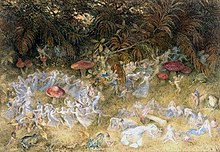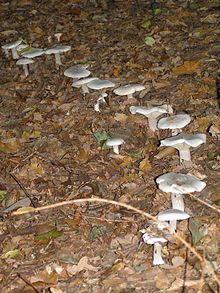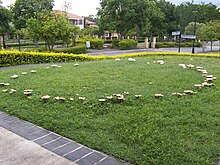Witch ring

As witch rings or fairy rings (English fairy rings) are called semicircular or round growth patterns of mushroom fruit bodies, which arise because the mycelium of a mushroom grows equally quickly in all directions. The diameter of these structures can be very large depending on age. Witch rings are formed by different types of mushrooms in very different locations.
At the end of the mycelial threads, what the vernacular calls "mushroom" forms, the visible fruiting body . As the nutrients in the soil in the inner area of the "circular mushroom accumulation" run out over time, the mycelium there dies and what remains is a ring-shaped structure, the so-called witch's ring. As a rule, a witch's ring is therefore a single organism. Under favorable conditions the mycelium can form fruiting bodies very quickly, so such rings can literally form overnight. In general, witch rings have a diameter of 20 cm to a few meters. The largest ring discovered so far measured about 600 meters in diameter. In Europe, such ring structures can occur in more than 60 of the known mushroom species.
The fungi often cause discolouration on lawns all year round, which is why witch rings are also counted among the lawn diseases.
etymology

The name Hexenring or Feenring goes back to popular belief , as one saw meeting places of witches or fairies in these round shapes , whose entry was magical or prohibited. Places of growth of special plants, for example those with special healing properties, are connected with spirit beings in different cultures.
Others
So-called fairy circles have also been observed, especially in Namibia . These are not circles of visible mushroom fruit bodies, but ring structures of higher plants, mostly grasses . The bare interior of the circles is very likely due to the activity of the 'sand termites' Psammotermes allocerus , which eat the grass in the vicinity of their nest.
Furthermore, turf that has been tread in a circle is sometimes referred to as witch's rings, which can arise during the rutting season of the deer when the roebuck drives the doe. However, these are rarely exactly circular.
photos
Witch ring-forming species

About 60 types of mushrooms are known that grow into witch rings.
One of the largest witch rings ever discovered was found near Belfort in France. This ring, formed by monk heads , is approximately 600 meters in diameter and is estimated to be over 700 years old. In the South Downs in the south of England there are large witch rings made of may mushrooms , the age of which is estimated to be several hundred years.
List of species
- White aniseed mushroom ( Agaricus arvensis )
- Meadow mushroom ( Agaricus campestris )
- Agaricus praerimosus
- Early Ackerling ( Agrocybe praecox )
- Fly agaric ( Amanita muscaria )
- Amanita phalloides ( Amanita phalloides )
- Pearl mushroom ( Amanita rubescens )
- Brownspore dwarf bovist ( Bovista dermoxantha )
- May mushroom ( Calocybe gambosa )
- Violet dusting ( Calvatia cyathiformis )
- Giant Bovist ( Calvatia gigantea )
- Chanterelle ( Cantharellus cibarius )
- Field funnelling ( Clitocybe dealbata )
- Nebelgrauer Fichterling ( Clitocybe nebularis )
- Clitocybe nuda
- Rinnigbereifter funnelling ( Clitocybe rivulosa )
- Chlorophyllum molybdites
- Common saffron umbrella ( Chlorophyllum rhacodes )
- Cortinarius bellus
- Rowed clubfoot ( Cortinarius glaucopus )
- Dark purple veil ( Cortinarius violaceus )
- Dung expensive ( Cyathus stercoreus )
- Disciseda subterranea
- Giant Rötling ( Entoloma sinuatum )
- Pig's ear ( Gomphus clavatus )
- Fragrant snail ( Hygrophorus agathosmus )
- Orange Snail ( Hygrophorus pudorinus )
- Spotted purple snail ( Hygrophorus russula )
- Monk's head ( Infundibulicybe geotropa )
- Fuchsiger red chalk knight ( Paralepista flaccida )
- Dirty red chalk knight ( Lepista sordida )
- Giant cream funnel ( Leucopaxillus giganteus )
- Lycoperdon curtisii
- Bottle dusting ( Lycoperdon gemmatum )
- Common giant umbrella ( Macrolepiota procera )
- Carnation Swindler ( Marasmius oreades )
- Hawk fungus ( Sarcodon imbricatus )
- Butter mushroom ( Suillus luteus )
- Straw pale knight ( Tricholoma album )
- Reddening Earth Knight ( Tricholoma orirubens )
- Tiger knight ( Tricholoma pardinum )
- Matsutake ( Tricholoma matsutake )
- Common earth knight ( Tricholoma terreum )
- Perigord truffle ( Tuber melanosporum )
Web links
Individual evidence
- ↑ Peter H. Raven , Ray F. Evert, Susan E. Eichhorn: Biology of plants . 4th edition. de Gruyter, 2006, ISBN 978-3-11-018531-7 , p. 315 .
- ↑ a b P. H. Gregory: Fairy rings; Free and tethered . In: Bulletin of the British Mycological Society . 16, No. 2, 1982, pp. 161-163. doi : 10.1016 / S0007-1528 (82) 80013-8 .
- ↑ Hanns Bächtold-Stäubli: Vol. 3: Freen - lumbago . In: Eduard Hoffmann-Krayer (Hrsg.): Concise dictionary of German superstition . Unchangeable photomechan. Reprint d. Issued 1930/1931. de Gruyter, 2012, ISBN 978-3-11-085804-4 , p. 1881 .
- ↑ a b c d e f g P. M. Kirk, P. F. Cannon, D. W. Minter, J. A. Stalpers: Dictionary of the Fungi , 10th. Edition, CABI, Wallingford 2008, ISBN 978-0-85199-826-8 , p. 253.
- ^ John Ramsbottom: Mushrooms & Toadstools . Collins, 1953, ISBN 1-870630-09-2 , p. 125.
- ^ P. J. Edwards: Effects of the fairy ring fungus Agaricus arvensis on nutrient availability in grassland . In: New Phytologist . 110, No. 3, 1988, pp. 377-381. doi : 10.1111 / j.1469-8137.1988.tb00275.x .
- ↑ B. Wang, B. Lu, D. H. Jia: Genetic relationships between Agaricus campestris fruit bodies from fairy rings based on ISSR markers . In: Acta Edulis Fungi . 16, No. 4, 2009, ISSN 1005-9873 , pp. 1-4.
- ^ Benjamin: Mushrooms: poisons and panaceas. P. 305.
- ↑ a b Y. Terashima, T. Fukiharu, A. Fujiie: Morphology and comparative ecology of the fairy ring fungi, Vascellum curtisii and Bovista dermoxantha , on turf of bentgrass, bluegrass, and Zoysiagrass . In: Mycoscience . 45, No. 4, 2004, pp. 251-260. doi : 10.1007 / s10267-004-0183-y .
- ^ Antonio Carluccio : The Complete Mushroom Book . Quadrille, 2003, ISBN 1-84400-040-0 , p. 75.
- ↑ a b c C. H. Dickinson: Fairy rings in Norfolk . In: Bulletin of the British Mycological Society . 13, No. 2, 1979, pp. 91-94. doi : 10.1016 / S0007-1528 (79) 80005-X .
- ↑ Chanterelle Fairy Ring .
- ↑ C. G. Dowson, A. D. Rayner, L. Boddy: Spatial dynamics and interactions of the woodland fairy ring fungus Clitocybe nebularis . In: New Phytologist . 111, No. 4, 1989, pp. 699-705. doi : 10.1111 / j.1469-8137.1989.tb02365.x .
- ↑ Olof Hjelm: Analysis of halogenated organic compounds in coniferous forest soil from a Lepista nuda (wood blewitt) fairy ring . In: Chemosphere . 32, No. 9, 1996, ISSN 0045-6535 , pp. 1719-1728. doi : 10.1016 / 0045-6535 (96) 00089-6 .
- ↑ E. Horak, A. E. Wood: Cortinarius Fr. (Agaricales) in Australasia. 1. Subgen. Myxacium and subgen. Paramyxacium . In: Sydowia . 42, 1990, pp. 88-168.
- ^ V. S. Evenson: Mushrooms of Colorado and the Southern Rocky Mountains . Big Earth Publishing, 1997, ISBN 978-1-56579-192-3 , p. 121.
- ↑ M. Eppinger: Field Guide to Mushrooms and Other Fungi of Britain and Europe . New Holland Publishers, 2006, ISBN 978-1-84537-474-7 , p. 114.
- ↑ J. Mercier, T. D. Carson, D. B. White: Fairy rings in turf associated with the bird's nest fungus Cyathus stercoreus . In: Plant disease . 83, No. 8, 1999, ISSN 0191-2917 , p. 781. doi : 10.1094 / pdis.1999.83.8.781d .
- ↑ Linus Zeitlmayr: Wild Mushrooms: An Illustrated Handbook . Garden City Press, Hertfordshire, 1976, ISBN 0-584-10324-7 , p. 80.
- ^ A. H. Smith, E. E. Morse: The Genus Cantharellus in the Western United States . In: Mycologia . 39, No. 5, 1947, pp. 497-534 [508-510].
- ↑ K. H. McKnight, R. T. Peterson, V. B. McKnight: A Field Guide to Mushrooms: North America . Houghton Mifflin Harcourt, 1998, ISBN 978-0-395-91090-0 , p. 209.
- ↑ D. M. Huffman: Mushrooms and Other Fungi of the Midcontinental United States (Bur Oak Guide) . University of Iowa Press, Iowa City, Iowa 2008, ISBN 978-1-58729-725-0 , p. 85.
- ↑ Cornelis Bas, Th. W. Kuyper, M. E. Noordeloos: Flora Agaricina Neerlandica - 3 . CRC Press, 1995, ISBN 9789054106166 , pp. 74-75.
- ↑ JH Choi, K. Fushimi, N. Abe, H. Tanaka, S. Maeda, A. Morita, M. Hara, R. Motohashi, J. Matsunaga, Y. Eguchi, N. Ishigaki, D. Hashizume, H. Koshino, H. Kawagishi: Disclosure of the "fairy" of fairy-ring-forming fungus Lepista sordida . In: Chembiochem . 11, No. 10, 2010, pp. 1373-1437. doi : 10.1002 / cbic.201000112 . PMID 20486242 .
- ^ Jean-Louis Lamaison: The Great Encyclopedia of Mushrooms . Könemann, 2005, ISBN 3-8331-1239-5 , p. 89.







